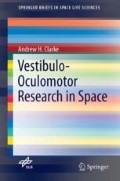Abstract
Given the influence of gravity as a reference for spatial orientation, the following questions arise for the microgravity scenario:
-
How does the vestibular system adapt to the absence in space, and to the reintroduction after landing, of the gravity vector?
-
Is the vestibule-oculomotor response simply modified by an amount equivalent to the otolith-mediated contribution?
-
Or does it adapt with a systematic latency or time constant to some other level?
Access this chapter
Tax calculation will be finalised at checkout
Purchases are for personal use only
References
Chapter 2: The Role of the Otoliths
Clarke AH, Engelhorn A, Scherer H (1996) Ocular counter-rolling in response to asymmetric radial acceleration. Acta Otolaryngol 116:652–656
Clarke AH, Grigull J, Mueller R, Scherer H (2000) The three-dimensional vestibulo-ocular reflex during prolonged microgravity. Exp Brain Res 134(3):322–334
Chapter 3: 3D VOR
André-Deshays C, Israel I, Charade O, Berthoz A, Popov K, Lippschitz M (1993) Gaze control and spatial memory in weightlessness. J Vestib Res 3:331–344
Baloh RW, Demer J (1991) Gravity and the vertical vestibulo-ocular reflex. Exp Brain Res 83:427–433
Barr CC, Schultheis LW, Robinson DA (1976) Voluntary, non-visual control of the human vestibular-ocular reflex. Acta Otolaryngol (Stockh) 81:365–375
Benson AJ, Viéville T (1986) European vestibular experiments on the Spacelab-1 mission. 6. Yaw axis vestibulo-ocular reflex. Exp Brain Res 64:279–283
Bles W, de Graaf B (1991) Ocular rotation and perception of the horizontal under static tilt conditions in patients without labyrinthine function. Acta Otolaryngol (Stockh) 111:456–462
Clarke AH, Teiwes W, Scherer H (1993a) Vestibulo-oculomotor testing during the course of a spaceflight mission. Clin Inv 71:740–748
Clarke AH, Teiwes W, Scherer H (1993b) Evaluation of the three-dimensional VOR in weightlessness. J Vestib Res 3(3):207–218
Clarke AH, Engelhorn A, Hamann C, Schönfeld U (1999) Measuring the otolith-ocular response by means of unilateral radial acceleration. Ann NY Acad Sci 871:387–391
Clément G, Lathan CE (1991) Effect of static tilt about the roll axis on horizontal and vertical optokinetic nystagmus and after-nystagmus. Exp Brain Res 84:335–341
Clément G, Viéville T, Lestienne F, Berthoz A (1986) Modifications of gain asymmetry and beating field of vertical optokinetic nystagmus in microgravity. Neurosci Lett 63:271–274
Clément G, Wood SJ, Lathan CE, Peterka RJ, Reschke MF (1999) Effects of body orientation and rotation axis on pitch visual-vestibular interaction. J Vestib Res 9:1–11
Cohen B, Kozlovskaya I, Raphan T, Solomon D, Helwig D, Cohen N, Sirota M, Yakushin S (1992) Vestibulo-ocular reflex of rhesus monkeys after spaceflight. J Appl Physiol 73:121S–131S
Collewijn H, van der Steen J, Ferman L, Jansen TC (1985) Human ocular counterroll: assessment of static and dynamic properties from scleral coil recordings. Exp Brain Res 59:185–196
Correia MJ, Perachio AA, Dickman JD, Kozlovskaya IB, Sirota MG, Yakushin SB, Beloozerova IN (1992) Changes in monkey horizontal semicircular canal afferent responses after spaceflight. J Appl Physiol 73:112S–120S
Dai M, Cohen B, Raphan T, McGarvie L, Kozlovskaya I (1994) Effect of spaceflight on ocular counterrolling and the spatial orientation of the vestibular system. Exp Brain Res 102:45–56
Glasauer S, Reschke M, Berthoz A, Michaud L, Hubner W (1993) The effect of spaceflight on gaze control strategy. In: Proc 5th Eur symp life sci res in space. ESA-SP 366:339–344
Groen E, De Graaf B, Bles W, Bos JE (1996) Ocular torsion before and after 1 hour centrifugation. Brain Res Bull 40:331–333
Igarashi M, Takahasi T, KuboT et al (1978) Effect of macular ablation on vertical optokinetic nystagmus. J Otorhinolaryngol Relat Spec 40:312–318
Jáuregui-Renaud K, Faldon M, Clarke A, Bronstein AM, Gresty MA (1996) Skew deviation of the eyes in normal human subjects induced by semicircular canal stimulation. Neurosci Lett 205:135–137
Kasai T, Zee DS (1978) Eye-head co-ordination in labyrinth defective patients. Brain Res 144:123–141
Kornilova LN, Bodo G, Kaspransky RR (1987) Sensory interaction in weightlessness. Physiologist 30:85–89
Lichtenberg BK, Young LR, Arrott AP (1993) Human ocular counterrolling induced by varying linear acceleration. Exp Brain Res 48:127–136
Manzey D (1998) Mental performance during short-term and long-term spaceflight. Brain Res Bull 28(215):221
Morrow MJ, Sharpe JA (1993) The effects of head and trunk position on torsional vestibular and optokinetic eye movements in humans. Exp Brain Res 95:144–150
Paige GD, Seidman SH (1999) Characteristics of the VOR in response to linear acceleration. Ann N Y Acad Sci 871:123–135
Skipper JJ, Barnes GR (1989) Eye movements induced by linear acceleration are modified by visualisation of imaginary targets. Acta Otolaryngol Suppl (Stockh) 468:289–294
Thornton WE, Uri JJ, Moore TP, Pool SL (1989) Studies of the horizontal vestibulo-ocular reflex in spaceflight. Arch Otolaryngol Head Neck Surg 15:943–949
Tomlinson RD, Schwarz DWF (1980) Analysis of human vestibulo-ocular reflex during active head movements. Acta Otolaryngol (Stockh) 89:184–190
Viéville T, Clément G, Lestienne F, Berthoz A (1986) Adaptive modifications of the optokinetic and vestibulo-ocular reflexes in microgravity. In: Zee DS, Keller EL (eds) Adaptive processes in visual and oculomotor systems. Pergamon Press, Oxford, pp 111–120
Wall C, Black FO (1984) Intersubject variability in VOR responses to 0.005–1.0 Hz sinusoidal rotations. Acta Otolaryngol Suppl (Stockh) 406:194–198
Author information
Authors and Affiliations
Rights and permissions
Copyright information
© 2017 The Author(s)
About this chapter
Cite this chapter
Clarke, A.H. (2017). The Three-Dimensional Vestibulo-Ocular Reflex During Prolonged Microgravity. In: Vestibulo-Oculomotor Research in Space. SpringerBriefs in Space Life Sciences. Springer, Cham. https://doi.org/10.1007/978-3-319-59933-5_3
Download citation
DOI: https://doi.org/10.1007/978-3-319-59933-5_3
Published:
Publisher Name: Springer, Cham
Print ISBN: 978-3-319-59932-8
Online ISBN: 978-3-319-59933-5
eBook Packages: Biomedical and Life SciencesBiomedical and Life Sciences (R0)

